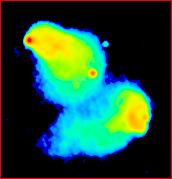 Image:
Image:3C 382 | B1833+326 |
| S178 | Alpha | FR | Class | ID | Spectrum | Best z | mag. | LAS | lg P178 | D |
|---|---|---|---|---|---|---|---|---|---|---|
| 21.7 | 0.59 | II | CD | Gal | 0.0578 | R = 13.58 | 186.00 | 25.04 | 188.8 |

| Size: | 212.4 × 204.0 arcsec² |
|---|---|
| LUT: | Logarithmic |
| Beam: | 4.5 arcsec |
| Frequency: | 1477 MHz |
| Method: | CLEAN/VTESS’ėˇ>4.5
|
| Telescope: | VLA B+C |
| Credits: | Leahy & Perley (1991) |
The radio structure shows several quasar-like features, some of which are better seen in the high-resolution image of Black et al. (1992). The core is very bright and there is a narrow jet to the NE feeding the compact hotspot. The lobe opposite the jet is displaced from the main axis in a similar way to some quasars, e.g. 3C 351.
The diffuse hotspot in the western lobe has a ring-like structure, and there is also a faint ring in the eastern lobe just behind the compact hotspot. Ring-like structures are seen in a number of radio galaxies, e.g. 3C 123 and 3C 303. It is tempting to speculate that they are caused by precession of the jet direction.
The host galaxy is an elliptical, but shows tidal distortions in its outer isophotes. It seems to be interacting with a barred spiral galaxy 85 arcsec to the ENE, projected just beyond the radio lobe. Roche & Eales (2000) claim that the two galaxies are connected by two filaments, although the connection is not visible in their image as reproduced.
The point source at the edge of the lobe, north of the core, is an
unrelated background object.
| Prev. | Data Page | Other images | Next | Search | Alphanumeric List | Icon List | Atlas Index |
|---|